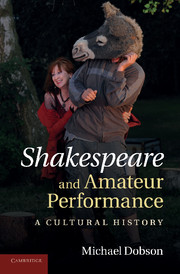Book contents
- Frontmatter
- Contents
- List of illustrations
- Acknowledgements
- Introduction: Shakespeare in culture
- 1 Shakespeare in private: domestic performance
- 2 Shakespeare in public: the resisted rise of the amateur dramatic society
- 3 Shakespeare in exile: expatriate performance
- 4 Shakespeare in the open: outdoor performance
- Conclusion
- Notes
- Index
2 - Shakespeare in public: the resisted rise of the amateur dramatic society
Published online by Cambridge University Press: 05 December 2011
- Frontmatter
- Contents
- List of illustrations
- Acknowledgements
- Introduction: Shakespeare in culture
- 1 Shakespeare in private: domestic performance
- 2 Shakespeare in public: the resisted rise of the amateur dramatic society
- 3 Shakespeare in exile: expatriate performance
- 4 Shakespeare in the open: outdoor performance
- Conclusion
- Notes
- Index
Summary
quince Is all our company here?
bottom You were best to call them generally, man by man, according to the scrip.
(A Midsummer Night's Dream, 1.2.1–3)The Kilkenny Theatrical Society, convening to hire, decorate and in some accounts even buy their town's playhouse (‘the small and elegant theatre,’ according to Sir John Carr, ‘is the private property of the gentlemen who perform’), marks an important halfway stage between the private theatricals of the eighteenth century and the emergence of amateur dramatic organizations as Britain still knows them. It was an example, however, which it proved all-but impossible to follow in England for the best part of a century. At the start of the nineteenth century, the founding in 1802 of what has been termed the country's ‘first amateur dramatic society’, the Pic-Nic Club, which unlike the Kilkenny theatricals was run on a formal, subscription basis, was greeted with moral panic. It was not until the start of the twentieth century, in 1901, that the establishment of the acknowledged pioneer of the Little Theatre movement, the Stockport Garrick Society, which definitely did buy a theatre of its own, could be celebrated as a breakthrough in the virtuous redemption of public life. By then the Pic-Nic Club had been forgotten, and enthusiasts instead hailed the Stockport Garrick and its emulators as marking a return to an imagined Elizabethan cooperative tradition of amateur theatricals supposedly depicted in the mechanicals' scenes of A Midsummer Night's Dream.
- Type
- Chapter
- Information
- Shakespeare and Amateur PerformanceA Cultural History, pp. 65 - 108Publisher: Cambridge University PressPrint publication year: 2011



